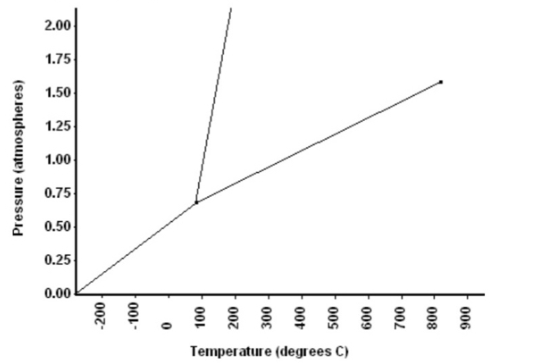Refer to the phase diagram below when answering the questions on this worksheet. Begin by adding S, L, and G to the three regions of the phase diagram. 2.00 1.75 1.50 1.25 1.00 0.75 0.50 0.25 0.00 Temperature (degrees C) 1) What is the normal freezing point of this substance?_100 °C 2) What is the normal boiling point of this substance?_350 °C 3) What is the normal boiling point of water? 100 °C 4) What is the normal freezing point of water? °C If I had a quantity of this substance at a pressure of 1.25 atm and a temperature of 300°C and then lowered the pressure to 0.25 atm isothermally (constant T), what phase transition(s) would occur? 5) Liquid to gas transition would occur 6) At what temperature do the gas and liquid phases become indistinguishable from each other? 800 °C What is this point called? If I had a quantity of this substance at a pressure of 0.75 atm and a temperature of -100° C, 7) what phase change(s) would occur if I increased the temperature to 600° C? At what temperature(s) would they occur? 001 007- (sə Jəydsoune) ənssəd
Refer to the phase diagram below when answering the questions on this worksheet. Begin by adding S, L, and G to the three regions of the phase diagram. 2.00 1.75 1.50 1.25 1.00 0.75 0.50 0.25 0.00 Temperature (degrees C) 1) What is the normal freezing point of this substance?_100 °C 2) What is the normal boiling point of this substance?_350 °C 3) What is the normal boiling point of water? 100 °C 4) What is the normal freezing point of water? °C If I had a quantity of this substance at a pressure of 1.25 atm and a temperature of 300°C and then lowered the pressure to 0.25 atm isothermally (constant T), what phase transition(s) would occur? 5) Liquid to gas transition would occur 6) At what temperature do the gas and liquid phases become indistinguishable from each other? 800 °C What is this point called? If I had a quantity of this substance at a pressure of 0.75 atm and a temperature of -100° C, 7) what phase change(s) would occur if I increased the temperature to 600° C? At what temperature(s) would they occur? 001 007- (sə Jəydsoune) ənssəd
Chemistry
10th Edition
ISBN:9781305957404
Author:Steven S. Zumdahl, Susan A. Zumdahl, Donald J. DeCoste
Publisher:Steven S. Zumdahl, Susan A. Zumdahl, Donald J. DeCoste
Chapter1: Chemical Foundations
Section: Chapter Questions
Problem 1RQ: Define and explain the differences between the following terms. a. law and theory b. theory and...
Related questions
Question
Need answers for blue parts

Transcribed Image Text:Refer to the phase diagram below when answering the questions on this worksheet. Begin by adding
S, L, and G to the three regions of the phase diagram.
2.00
1.75
1.50
1.25
1.00
0.75
0.50
0.25
0.00
Temperature (degrees C)
1)
What is the normal freezing point of this substance?_100
°C
2)
What is the normal boiling point of this substance?_350
°C
3)
What is the normal boiling point of water? 100
°C
4)
What is the normal freezing point of water?
°C
If I had a quantity of this substance at a pressure of 1.25 atm and a temperature of 300°C and
then lowered the pressure to 0.25 atm isothermally (constant T), what phase transition(s)
would occur?
5)
Liquid to gas transition would occur
6)
At what temperature do the gas and liquid phases become indistinguishable from each other?
800
°C
What is this point called?
If I had a quantity of this substance at a pressure of 0.75 atm and a temperature of -100° C,
what phase change(s) would occur if I increased the temperature to 600° C? At what
temperature(s) would they occur?
7)
Pressure (atmospheres)
00L
Expert Solution
Step 1
The phase diagram given is,

Trending now
This is a popular solution!
Step by step
Solved in 4 steps with 4 images

Knowledge Booster
Learn more about
Need a deep-dive on the concept behind this application? Look no further. Learn more about this topic, chemistry and related others by exploring similar questions and additional content below.Recommended textbooks for you

Chemistry
Chemistry
ISBN:
9781305957404
Author:
Steven S. Zumdahl, Susan A. Zumdahl, Donald J. DeCoste
Publisher:
Cengage Learning

Chemistry
Chemistry
ISBN:
9781259911156
Author:
Raymond Chang Dr., Jason Overby Professor
Publisher:
McGraw-Hill Education

Principles of Instrumental Analysis
Chemistry
ISBN:
9781305577213
Author:
Douglas A. Skoog, F. James Holler, Stanley R. Crouch
Publisher:
Cengage Learning

Chemistry
Chemistry
ISBN:
9781305957404
Author:
Steven S. Zumdahl, Susan A. Zumdahl, Donald J. DeCoste
Publisher:
Cengage Learning

Chemistry
Chemistry
ISBN:
9781259911156
Author:
Raymond Chang Dr., Jason Overby Professor
Publisher:
McGraw-Hill Education

Principles of Instrumental Analysis
Chemistry
ISBN:
9781305577213
Author:
Douglas A. Skoog, F. James Holler, Stanley R. Crouch
Publisher:
Cengage Learning

Organic Chemistry
Chemistry
ISBN:
9780078021558
Author:
Janice Gorzynski Smith Dr.
Publisher:
McGraw-Hill Education

Chemistry: Principles and Reactions
Chemistry
ISBN:
9781305079373
Author:
William L. Masterton, Cecile N. Hurley
Publisher:
Cengage Learning

Elementary Principles of Chemical Processes, Bind…
Chemistry
ISBN:
9781118431221
Author:
Richard M. Felder, Ronald W. Rousseau, Lisa G. Bullard
Publisher:
WILEY